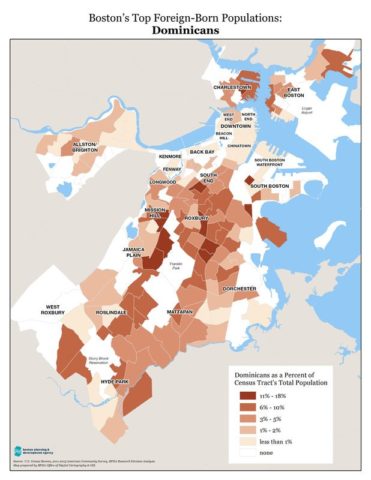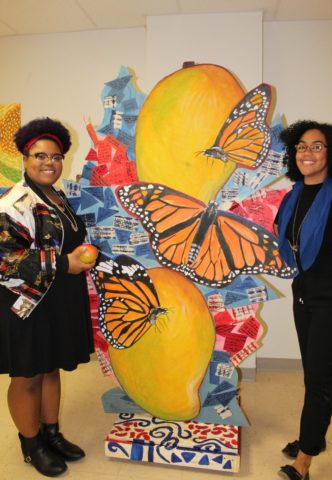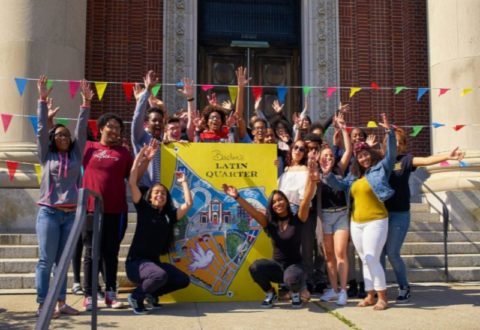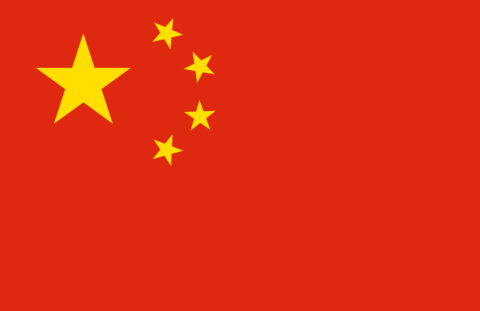Merengue Restaurant
156 Blue Hill Ave, Boston, MA
Phone: (617) 445-5403
One of the only restaurants in Boston specializing in Dominican cuisine, Merengue is named after the national dance of the Dominican Republic. Its carefully arranged, flamboyant artistry is evident in dishes that have attracted clientele like David Ortiz, Pedro Martinez, and Manny Ramirez.
Dominicans

The daily heroics of many Dominican immigrants struggling to make a living in Boston go largely unnoticed. Most Bostonians only recognize local Dominican superstars David Ortiz and Pedro Martinez. Nevertheless, the quiet influence of Dominicans are transforming both communities in Boston and in the Dominican Republic.
“When America Sneezes:” A Troubled Dependency
As the old saying goes, when America sneezes, the world catches a cold. Nowhere in the 20th century was the adage more fitting than in the Dominican Republic. Newly independent, first from Spain and then from Haiti, Dominican leaders turned to the United States for loans and investments in order to pay off substantial debts and protect the nation’s sovereignty. Exploiting the relationship, Americans bought up large tracts of land for sugar plantations and controlled all imports and exports, effectively turning the nation into a U.S. colony anchored around growing, milling, and refining sugar. While profitable for American growers, the new plantation economy was very vulnerable to the movement of the sugar market, and created food shortages for Dominicans as farmland was devoted to sugar. American sports like baseball became popular, and connections made between the two nations foreshadowed future immigration to the U.S.
Opening the Gates
Emigration to America was effectively barred under Dominican dictator Rafael Trujillo’s rule. Upon his assassination in 1961, visas began to be issued again, and Dominican emigration became possible. When the first free elections in the nation’s history elected a socialist to the Presidency in 1963, U.S. President Lyndon Johnson sent 40,000 marines to the island to quash a potential “Communist takeover.” Fleeing such political unrest, many migrants began to leave. While some were political dissidents, many were laborers fleeing harsh conditions caused by eras of unsustainable economic policies.
At first rural migrants from northern provinces migrated, followed by a bigger wave of urban workers escaping unemployment and crime. Economic instability and interference from the U.S. lasted throughout the 1980’s, as more and more Dominicans left their cities and villages. Pioneering families hosted other migrants in Boston and helped them find jobs. Quietly and quickly, Boston’s Dominican community grew through personal connections. In Boston’s Jamaica Plain, a significant community of Dominicans formed, many originating from villages around the southern city of Bani. Today, “Banilejos” form much of Boston’s Dominican community.
Dominicans in Lawrence
At the same time early Dominican communities moved into Boston, Dominicans settled rapidly in Lawrence, MA. Historically a center of industry and immigration, the city attracted Dominicans from New York because it offered shelter from New York’s urban decay. Lawrence offered decent housing and jobs for immigrants in the past, albeit all white before then. In Lawrence, Dominicans faced tremendous hostility and a lack of community investment from white leadership. Two nights of anti-immigration rioting in 1984 marked a turning point for Dominican representation in Lawrence and in Boston. It became clear that Dominicans needed a stronger voice in the city, and activists organized to strengthen and protect Lawrence’s Dominicans. Today, Dominicans are credited for restoring the population and institutions of a once-dying town, repopulating churches, opening small businesses, and sustaining the manufacturing industry in Lawrence. Lawrence has become a powerful center of political representation for Dominicans in New England as well: Lawrence’s mayor, Dan Rivera, as well as many members of Lawrence City Council, are proudly Dominican.
Overlapping Lives: Between the Domican Republic and Boston
The money sent back by Dominican immigrants in Boston and across the U.S. add up to more than half the budget of the Dominican economy. In Boston, Dominicans lead uniquely transnational lives, where American influences shape life back on the island.
Dominican culture permeates daily life in America. Dual citizenship encourages many first-generation Dominicans in America to participate in elections on the island, and an immigrant can hold office on the island while living in America. Racial discrimination faced by Dominicans in Boston have inspired greater solidarity with neighboring Haiti. Greater economic independence for Dominican women in Boston have also changed gender norms on the island. Baseball stars like David Ortiz are icons both in Boston and the Dominican Republic. These cultural, political and economic ties blur the lines between the two nations, and allow immigrants to live truly transnational lives.

Dominican artist Iris Lapaix (right) and Haitian artist Chanel Thervil (left) stand next to “Mariposas and Mangos,” an art exhibition displayed at the Hyde Square Task Force in Boston’s Latin Quarter. Potent cultural symbols of both nations, “Mariposas and Mangos” aims to address cultural and ethnic tensions between Dominicans and Haitians by offering a space for shared understanding. The butterflies represent the Mirabal sisters, Dominican political advocates against the Trujillo regime who were assassinated in 1960.

One of the earliest centers of Latinx culture in Boston, the Jackson/Hyde Square neighborhood of Jamaica Plain was recently designated a Cultural District by the City of Boston. Here, members of the Hyde Square Task Force celebrate the proclamation of Boston’s Latin Quarter in 2018. The Hyde Square Task Force has long been an advocate for Boston’s Latinx community, sponsoring artistic and educational opportunities for Dominican residents of Jamaica Plain.
Finding Place in Boston
Dominican immigrants represent a major part of Boston’s Latinx population, and as the fastest-growing immigrant group in the city, Latinx Bostonians are chiefly responsible for growing Boston’s population. Boston’s Latinx community is not a monolith. Rather, it is a collection of various ethnic communities from many parts of Central and South America. While mainly Christian, Latin-Bostonians worship in traditional masses as well as newer evangelical churches.
Dominicans in Boston have been prodded by gentrification and development, settling and resettling across the city and beyond. Early migrants settled in the South End and Cambridgeport near existing Puerto Rican communities, but by the 1980s Jamaica Plain became the heart of the Dominican community due to gentrification. Today, many Dominicans live in Dorchester, Roxbury, and Jamaica Plain, and many are moving out to Latinx-dominated cities in the north like Lawrence and Chelsea, spurred largely by housing costs.
Today, Boston’s Dominicans work in a variety of manufacturing and service sectors, primarily in shipping and furniture moving businesses, with younger generations increasingly in professional fields. Dominicans in Boston still face challenges due to a lack of community resources (such as those that provide ESL and financial lessons for new immigrants). While comfortable with other members of the Latinx community, Dominicans and Haitians in Boston share an uneasy relationship, and anti-Black discrimination in Boston mirrors the prejudices back on the island Dominicans share with Haiti.
Poised with the key to the city’s future, Dominicans represent a Latinx community that is driving the city’s growth, whether as Boston sports icons or as food service workers within BC High.
Community Spotlights
Please click on the map dots to learn more about each location. They represent many different aspects of the Dominican community. Each location contains a general description as well as additional photos and contact information.
-
-
Alex’s Chimis
358 Centre St, Jamaica Plain, MA
617-522-5201
Specializing in rotisserie chicken and chimis—a Dominican “hamburger” with green tomatoes and fried chicken or beef, Alex’s Chimis has remained an iconic eatery for over twenty years, serving delicious chicken at an always affordable price. Centre Street has long been a hub of Boston’s Dominican community, and remains so even as Jamaica Plain and many parts of Boston undergo gentrification and sweeping demographic change. -
Dominican Development Center
42 Seaverns Ave, Boston, MA
http://www.dominicandevelopmentcenter.org/
Phone: (617) 524-4029
The Dominican Development Center is one of the largest Dominican immigrant advocacy groups in Boston. A cornerstone of the Dominican community, the DDC helped sponsor some of the first demographic studies of the Dominican community in the greater Boston area. Today, the DDC provides ESL classes and citizenship classes to immigrants, and specializes in empowering Dominican women and domestic workers to seek stable jobs and leadership opportunities. -
Hyde Square Task Force
30 Sunnyside St, Boston, MA
Phone: (617) 524-8303
Founded in the 1980s by neighborhood leaders looking to stem the spread of violence in Jamaica Plain, the Hyde Square Task Force has always been focused on empowering Afro-Latinx teenagers and young adults in areas of artistic expression and civic engagement. Their Youth in Action initiatives support Afro-Latin arts programs in dance, music, and theater, as well as education programs to prepare high school students for college and promote civic engagement and community organization. Recent artistic exhibitions include “Mariposas y Mangos,” a partnership between Haitian and Dominican artists seeking to address anti-blackness and cultural tensions among Boston’s Afro-Latinx community. -
Iglesia Hispana de la Comunidad
85 Seaverns Ave, Jamaica Plain, MA
617-232-1416
Known as the Hispanic Community Church of Boston, the Iglesia Hispana is an evangelical Christian church that serves a variety of Hispanic cultures, including many Dominicans. Led by the charismatic Pastor Cesar Depaz, the church envisions itself as a community of love and family for many immigrants who have left their relatives back home.
Dominican Community Spotlights
Themes
- Seeds for later migration planted by US influence over Dominican Republic in 1800s
- Newly independent, the DR is in debt and seeks foreign investment
- United States buys mass tracts of land for sugar plantations
- Reliance on American investment and the price of sugar weakens economy
- Rafael Trujillo’s dictatorship lasts until 1961, when the U.S. quells a popular uprising and helps install Trujillo’s successor
- Emigration begins increasing as more visas become available after 1961
- Dominicans in Boston first settle around the South End but gentrification pushes them out to Jamaica Plain in the 1980s
- Most early migrants come from northern DR as well as Peravia province
- In Jamaica Plain, a settlement of Dominicans from Miraflores village develops
- Many rely on close family and kin connections to sponsor settlement
- A greater proportion of working class Dominicans begin arriving from the 1980s onwards
- In August 1984, riots break out between White and Latinx residents of Chelsea over multiple nights
- Migration surges in late 1980s to early 1990s
- Increased gentrification and the growth of Lawrence and Chelsea as centers of the Latinx community result in many Dominicans leaving Boston
- Political representation increases in predominantly Latinx suburbs as Dominicans seek public office
- In Boston, advocacy groups like the Hyde Square Task Force seek to create a new “Latin Quarter”
78k
Dominicans in Greater Boston with 37k in Boston
2nd
largest immigrant group in Boston
60%
of Dominicans are first generation immigrants
8%
of Dominicans are homeowners.
$29,800 is the median annual income
551 own businesses







